With kaleidoscopic ingenuity, Alê Abreu and his animators initially reveal the immensity of their evolving Brazilian world that can be contained within a child’s hand, reflective of the significance of the boundless vision of a person of any age, big or small.
Boy and the World [O Menino e o Mundo]’s inclusive stream-of-consciousness approach to scenic construction, equal parts whimsical and cautionary, often feels like an amalgamated template of recent indie games like Papo and Yo (2012), which also features a vibrant Brazilian favela, Hohokum (2014)’s gleefully dynamic world-skipping, or Journey (2012)’s graceful pilgrimage. The painterly collage-style animations of Caroline Leaf find a tinge of relevance in the mixed media presentation as well as the Zen-infused storytelling in Studio Ghibli’s Tale of the Princess Kaguya (2013) with its application of white, canvas-like backgrounds. In the wildly creative detours through rural and urban environments with no intelligible dialogue, Boy and the World moves rhythmically like a video game but also exhibits highly cinematic tendencies in its seventy-five-minute narrative that feels like a thematic series of short films.
Ruben Feffer and Gustavo Kurlat’s sound design and music are, at times, indistinguishable from one another. Every timbre is so impressively considered that environmental sound effects, whether originating from indigenous wildlife or man-made machines, are produced by acoustic instruments with varying textural approaches. Speech patterns are comparably expressed in scrambled Portuguese, which sound vaguely Scandinavian at times and English at others to evoke the sense of universal language and childhood experience of discovery. The film’s buoyant pan flute theme serves as an aural beacon of hope and sensory symbol of the boy’s father through his search for him in increasingly desolate and lonely landscapes.
Across the amorphous peak-valleys, the nomadic boy’s surrealistic journey unveils the capitalistic exploitation of workers and the deforestation at the hands of hungry industry and an unnamed fascistic regime’s rise to power, exhibited in an insect-like swarm of soldiers and a battalion of elephantine tanks masquerading as a parade through a city plaza. The increasingly militaristic feeling is compounded in the occasional aerial shot where a cluster of cotton-pickers on a plantation appear as ants operating in dehumanizing synchronicity in accordance with the overtaxing rhythms of big business. When the camera zooms in, animators wring out sympathy for common, oppressed people, whose elongated faces communicate a certain weariness that’s verbally inexpressible.

The sense of manipulation begins creeping into every facet of life from simple rural plot to bustling urban center. In one of the most entertaining segments, Boy and the World skewers television advertisements’ mindlessness in close-ups of trendy shoes, clothing, and cuisine, embellished with sparkling tags and juxtaposed with indecipherable revelry of spokesmen and women. Director Abreu wants his audiences both young and old to consider the impact of the demanding and ultimately empty modern lifestyle’s stresses upon the well-being of the planet and various laborers throughout the world. While this film is isolated to a region of Brazil, the maligned workers could easily double as overworked men and women in a Chinese Apple factory.
In a pronounced effort to condemn current practices, the film occasionally slips into a bit of galvanizing heavy-handedness that conflicts with its generally beautiful suggestiveness and innovative animalification of both environment and objects alike. At its most abstract, Boy and the World succeeds with flying colors and becomes as rewarding as any interactive experience, harnessing the rollicking imagination and innovation of the aforementioned indie games. In searching for emotional purpose through cycles of life, there is hope in the continual renewal of perspectives that the film and the impressionable young boy demonstrate.
- Boy and the World screens twice during the Wisconsin Film Festival as part of the “Big Screens, Little Folks” series: at Sundance Cinema 1 on Fri, Apr 10 (3:45p), and at the Union South Marquee on Sat, Apr 11 (1:45p). Tickets are still available for both showtimes.

